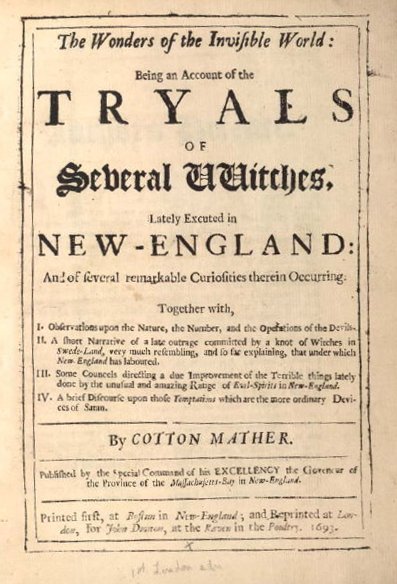If you are interested in one of the most fateful chapters of early American history and want to experience the Salem witch trials from the viewpoint of a young girl, there is much to like in The Heretic's Daughter
Title page of "Wonders of the Invisible World," 1693, by Cotton Mather, John Dounton, London, 1693.
The book starts off well, with author Kathleen Kent bringing to life the 17th-century town of Andover, Massachusetts and its daily life. Andover, a neighboring town to Salem Village, was still not far enough away to escape the atmosphere of fear and finger-pointing that started there. Kent does a good job of introducing factors that led to a general feeling of paranoia, dread and depression in the Massachusetts winter of 1691—the threat of Indian raids, smallpox outbreaks, bad harvests.
Her depiction of the claustrophobic and beyond-unsanitary conditions of the prisoners in Salem Jail is also well-done. It's a little known fact, or at least, not as frequently written about, how long the accused spent in the Salem jail. Some, even after they were exonerated for witchcraft, had to remain in prison because their families couldn't afford to pay their fees. The victim was expected to pay the costs of his own imprisonment.
Somewhere about halfway through, however, the book loses its way a little. Kent's narrator, Sarah Carrier, tells the story in increasingly florid metaphor, which gets progressively harder to slog through. "A child is like an early spring bulb that carries all the resources needed within its skin for the first push through the soil towards the sun. And just as a little bit of water can start the bulb to grow, even through fissured rock, so can a little kindness give a child the ability to push through the dark."
Passages like this one repeatedly use the farm and harvest to make a point. We get it, farming was life to these people. "But then, as I lay sweating in bed, restless and prickly, it came to me that to harvest a field of corn one does not wade into the dark middle of things and cut the stalks from the inside out. It is best done starting with the outside ears and working inward, stalk by stalk, keeping the light of the sun always at one's back so that its rays can illuminate each ear of corn, be it whole and sweet or black and blighted. And in this way does one make a meal that feeds a starving body back to wholeness."
The book is being told from the perspective of an elderly Sarah telling her granddaughter her childhood memories of the events of Salem and Martha Carrier. Surely her life had expanded a little beyond the hard life of the farm by her dotage? Or at least, she could tell it like it was, rather than constantly reverting to metaphor? "I believe many of us would peel ourselves away from our immortal selves as easily as the skin from a boiled plum if it meant we could remain on the earth for awhile, our bellies full and our beds warm and safe at night."
It's not that Kent is a bad writer or that the imagery is bad—it just gets a bit much. The author is a descendant of Martha Carrier, so I'm sure all of the flowery phrasings were her attempt to do justice to her ancestors. Her recently published book, The Wolves of Andover, which I haven't read, is a story about Martha Carrier's meeting her husband Tom, and his life before coming to America. His shadowy past was one of the weaker aspects for me of The Heretic's Daughter, as Kent could never adequately explain why the father was able to escape the persecution most of the rest of his family was subjected to.
Memorial to the victims of the Salem witch trials, Salem, Massachusetts
I wish her characters had a stronger reaction when told of the first executions. There is a scene where they mention Bridget Bishop, the first person who was hanged in June. But surely people must have realized how seriously crazy things were getting when they hanged five women—Rebecca Nurse, Sarah Good, Elizabeth Howe, Susannah Martin and my ancestor Sarah Wildes on July 19, 1692. Kent's characters all seem so stoic, thinking that reason or the distance from Salem to Andover will protect them. Kent is entitled to her interpretation. Maybe for many it was like walking through a bad dream until the blow finally came.
Book #7 in reading challenge Cannonball Read 3, sponsored by Pajiba




0 comments:
Post a Comment